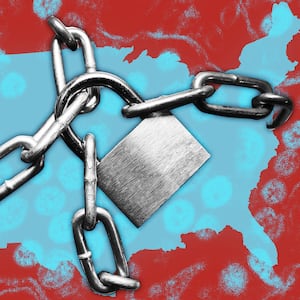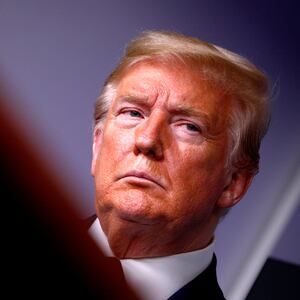On Tuesday, Pranish Kantesaria drove to three pharmacies in Austin, Texas, before he was able to find hydrocortisone, a generic medicine his infant daughter could die without.
Along with Americans struggling to obtain hand sanitizer and frontline medical professionals desperate for masks or other personal protective equipment (PPE), a new supply issue has become inescapable as the coronavirus pandemic has ravaged the United States: life-saving drugs.
As director of pharmacy at Baylor Scott & White Institute for Rehabilitation in Austin, Texas, Kantesaria should—at least, in theory—have an inside track. But, in addition to his personal experience, Kantesaria said he’s encountered more and more hurdles in ordering meds for his job.
“We’re short on blood-thinners already, but eventually we could be short on everything,” Kantesaria said. “Antidepressants, blood pressure meds, everything.”
“If I cannot order them from my distributor, that usually means that the distributor doesn’t have anything in stock,” he continued. “Everybody gets their drugs through one of three wholesalers: AmerisourceBergen, McKesson, and Cardinal.”
He saw his own frustrating experience as a harbinger of things to come. And a slew of experts are sounding the same alarm, telling The Daily Beast that they’re afraid for themselves, for their patients, and for the country.
Americans have been warned for months about possible drug supply shortages. In fact, before the coronavirus outbreak was even on the national radar, in December 2019, there were 264 drug shortages being monitored by the American Society of Health-Systems Pharmacists. (They define a shortage as any “supply issue that affects how the pharmacy prepares or dispenses a drug product or influences patient care when prescribers must use an alternative agent.”)
But with projected U.S. deaths ranging into the millions, the possibility of drug shortages is much more complicated—and more dire—than it was just a few months ago. And a drug supply crisis during a deadly pandemic could have especially brutal ripple effects on an already strained healthcare system.
“I know that we will run out of essential drugs in the coming months,” said one internal medicine physician at a major hospital in California who asked to remain anonymous because she wasn’t cleared to speak to the press. But it’s hard to focus on any particular big-picture issue when “everyone is so scared about PPEs and getting sick from COVID-19 because no one in the U.S. is adequately protected,” she added.
As has been previously reported, a shortage of ventilator drugs is the most pressing—and headline-grabbing—issue during the novel crisis in America’s hospitals. Several physicians and pharmacists told The Daily Beast on Thursday they were worried about shortages for drugs like these that are specifically essential to how we treat COVID-19.
More than a dozen sedatives, anesthetics, painkillers, and muscle relaxants—all of which are used to help manage patient pain and comfort levels during mechanical ventilation—are in short supply, Stat News first reported last week. They cited data from Vizient, a group purchasing organization that negotiates contracts for medicines on behalf of about 3,000 hospitals and health-care facilities across the country.
“You can’t intubate someone without one of those paralytic agents and sedatives and pain relievers,” said Erin Fox, an adjunct associate professor in the Department of Pharmacotherapy for the University of Utah who tracks drug shortages across the country and directs the drug-information service at the university’s four affiliated hospitals.
“I’m really glad that we’re talking about getting more ventilators, but it’s got to come with more medicine at the same time,” Fox told The Daily Beast.
As Dan Kistner, group senior vice president for pharmacy solutions at Vizient, put it, having a ventilator without the necessary medications to meet this new, “unprecedented” demand “will be like having a car but no gas.”
According to Michael Ganio, senior director of pharmacy practice and quality for the American Society of Health-System Pharmacists, which represents 45,000 pharmacists, student pharmacists, and pharmacy technicians, the factors behind the shortage are myriad. But they include citizens stocking up on their meds to prepare for a lockdown, pandemic-related supply chain disruptions where most drugs are made in China and India, and a significant increase in demand from the thousands of patients surging into the health-care system, he said.
About 90 percent of the core components of widely-used antibiotics like amoxicillin, doxycycline, and penicillin are manufactured in China, where manufacturing disruptions from the pandemic may not make themselves known to the supply chain for several weeks, experts say. In fact, most active pharmaceutical ingredients in all drugs are currently manufactured in China, after which many head to India, the world’s leading supplier of generic drugs, where those active ingredients are processed. Some companies in India have also already reported supply chain problems, according to a letter to customers released by AmerisourceBergen on March 31, which was reviewed by The Daily Beast. The letter cited “challenges in staffing, mobility and absenteeism” in manufacturing facilities.
Though there is concern for drugs across the board, for now, pharmacists and physicians are most worried about the drugs needed to fight the pandemic.
“Without a laser focus on quickly ramping up the supply of the medications that are required for use of a ventilator, the situation will be dire for the thousands of COVID-19 patients who will require that level of care,” Kistner said.
And cutbacks in other parts of the system—like halting elective surgeries—won’t solve the problem, either.
“COVID-19 patients who need a ventilator require deeper levels of sedation and are on ventilators for a longer time, so these patients are consuming a much higher quantity in a 24-hour period than would be used in an elective surgery,” said Ganio.
“Serious, critical medications are in short supply already,” he added. “And as the pandemic spreads and other areas surge, they’re going to have those same problems.”
But these concerns are not limited to opioids, paralytics, and sedatives. Experts, pharmacists, and patients have warned that (White House-fueled) hype surrounding COVID-19-related therapies that use azithromycin and hydroxychloroquine has threatened to endanger access to those meds in the U.S. And albuterol, which is used for asthma, is already experiencing a national shortage.
The drug industry is notoriously opaque, and it could be several weeks—or even months—before Americans feel the effects of Chinese or Indian supply chain disruptions on anything from blood pressure medications to antidepressants and antibiotics.
“What’s different about the situation we’re facing right now is that there’s an increased surge,” said Fox. “Unlike ventilators and masks, drugs aren’t quite as easy to surge up. We don’t have factories with extra capacity, and we can’t just 3D print some drugs and call them ‘good.’”
It should be noted that the Trump administration has been in talks with India to lift restrictions—put in place by New Delhi to ensure that the country had enough medicine for an outbreak—and allow the U.S. access to pharmaceutical ingredients, as NBC News reported. A spokesperson at the State Department said it was “collaborating” with India “to try to ensure that critical manufacturing and supply chains for pharmaceuticals, health care technology and personal protective equipment remain open even as large portions of our countries are shut down to reduce the risk of transmission.”
Still, said Kantesaria, looking ahead: “You could see a peak of death from COVID-19, and then another peak of hospitalizations from other things we can’t treat due to a medication shortage.”
And a drug shortage could boomerang badly.
“Let’s take blood pressure meds for example,” said Kantesaria. “When people don’t take their blood pressure meds, their blood pressure gets uncontrolled, and then sometimes they have a stroke and they bleed into their brain. Now you have to treat the stroke, which means they’re going to the hospital, which is already full.”
“If we don’t have enough anti-depressants, there’s an increase in suicide rates,” he said. “It’s even little things. A lot of people take Flomax [a urinary retention medication]. Without that, there might be an increase in urinary continence, then urinary tract infections, then you’re back in the hospital.”
Ganio, for one, was quick to push back on the idea that the situation would get that dire.
“Pharmacists tend to find alternative treatments,” he said, noting they have for decades addressed shortages and solved problems, often without physicians ever knowing something was amiss. “For average patients, the best message is not to panic. There’s no need to run and out and get a six month supply of your drug, and doing that can actually lead to a shortage.”
Still, frontline medical workers may feel like they’ve seen this movie before.
“It’s better to prepare now rather than be blind-sided the way that we were for PPE and ventilators,” the California doctor said.



